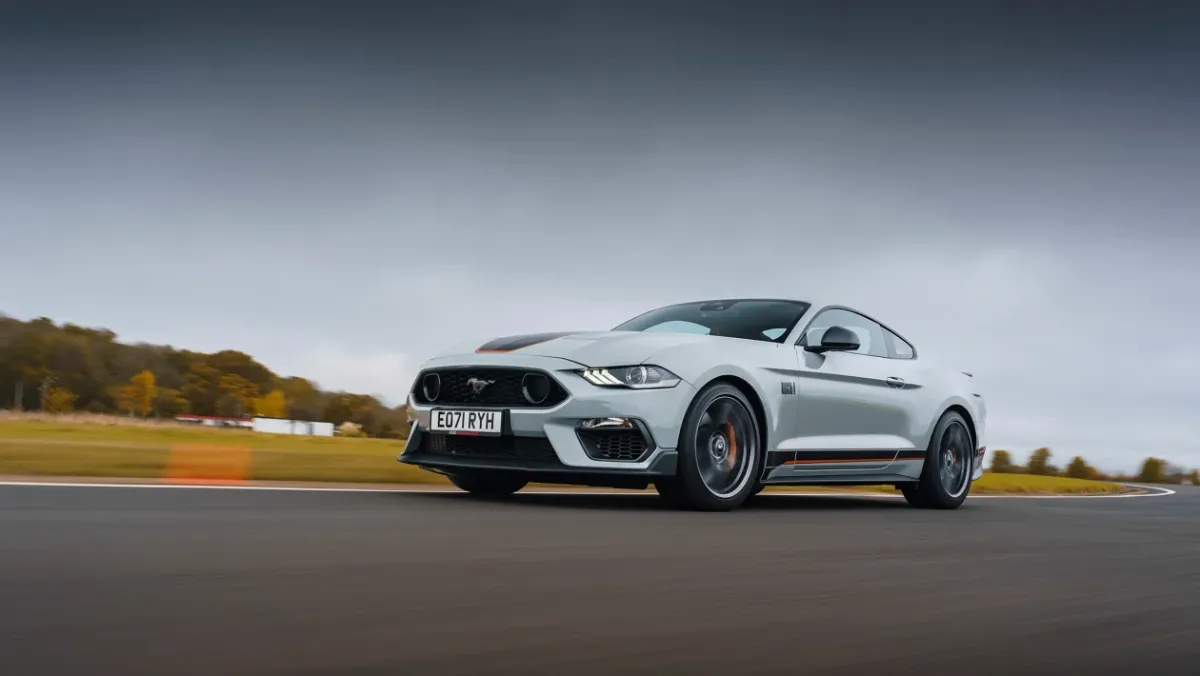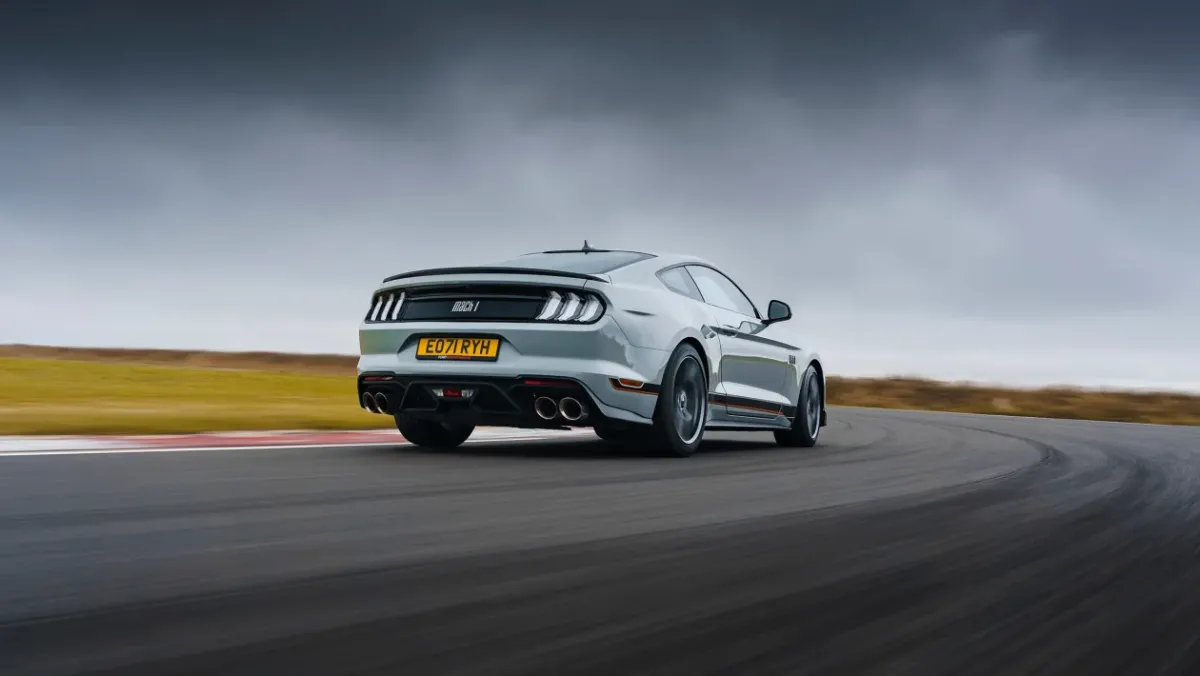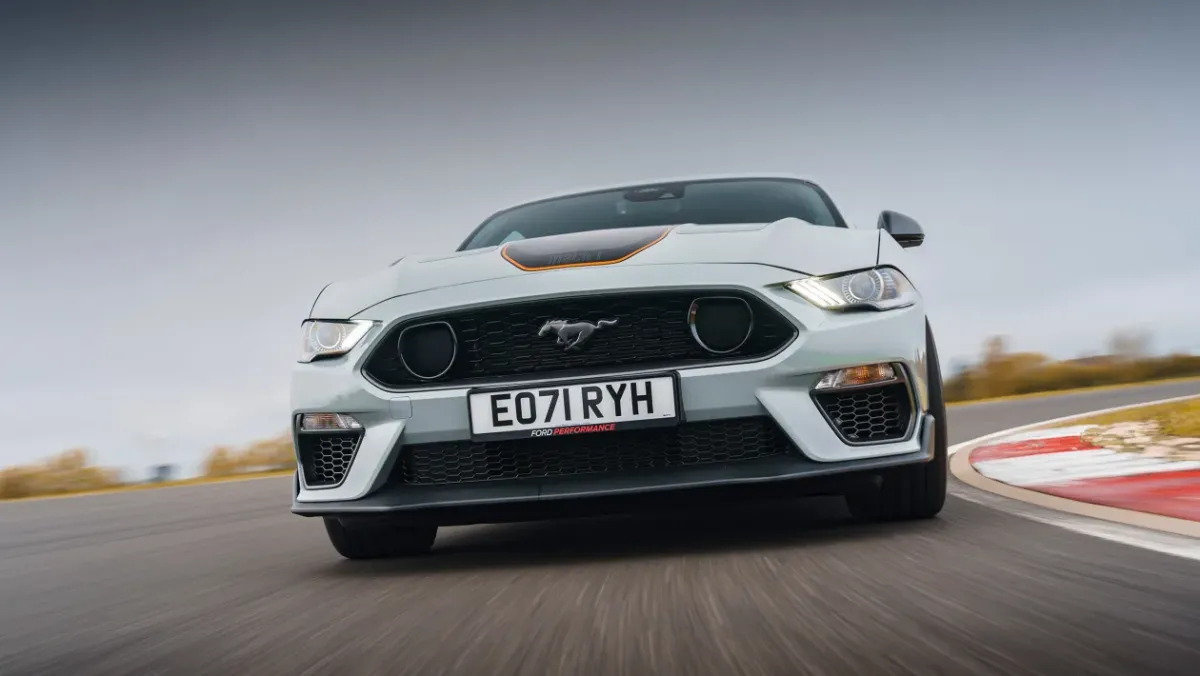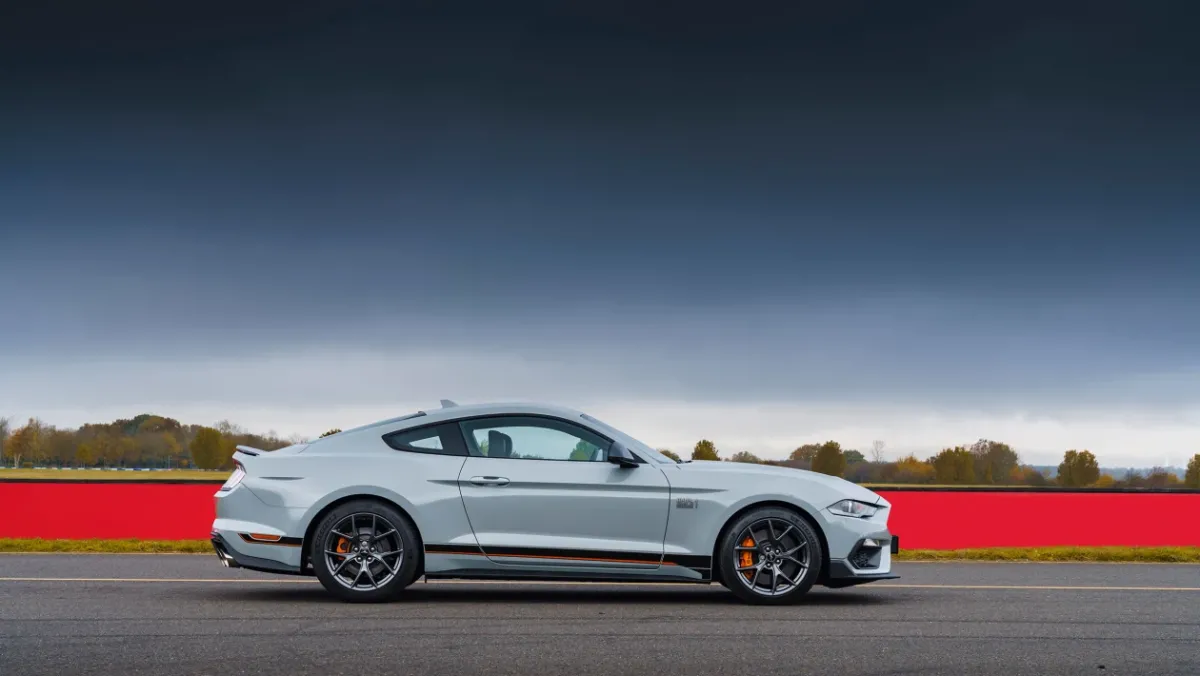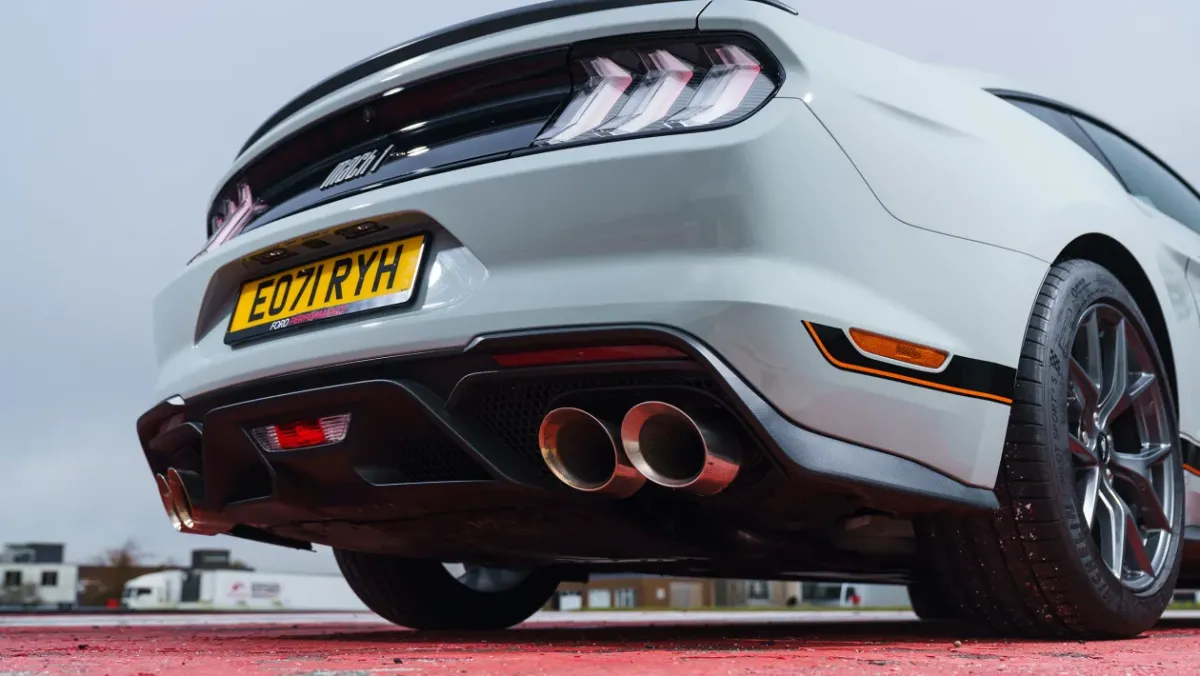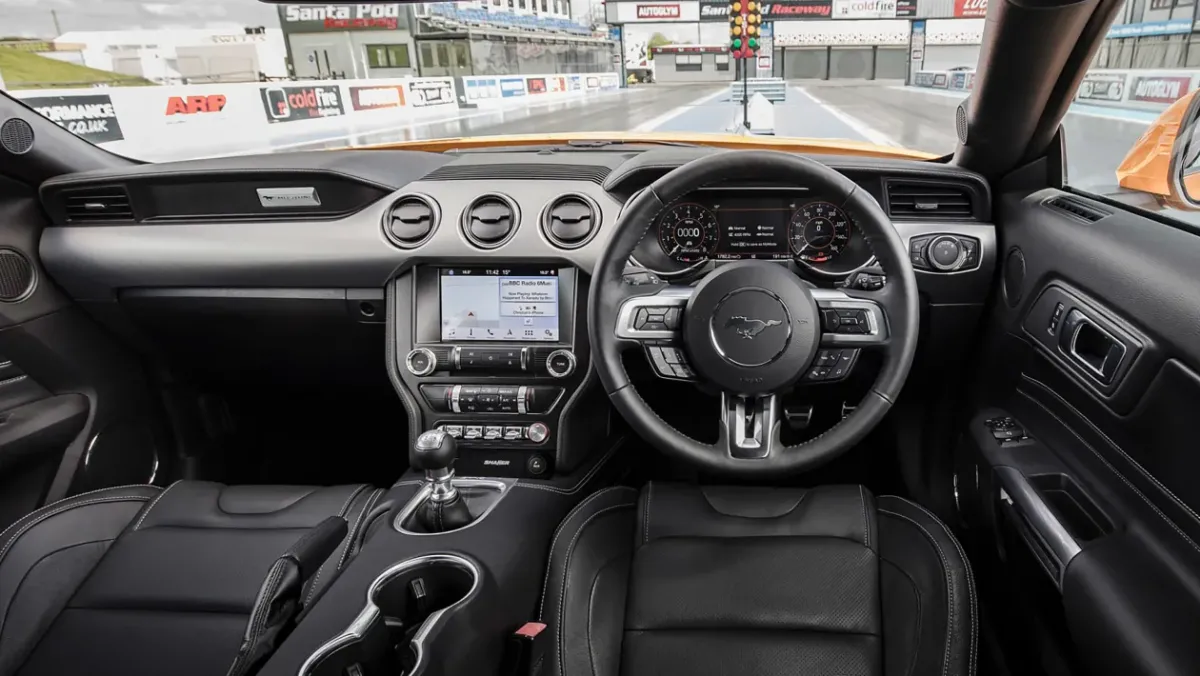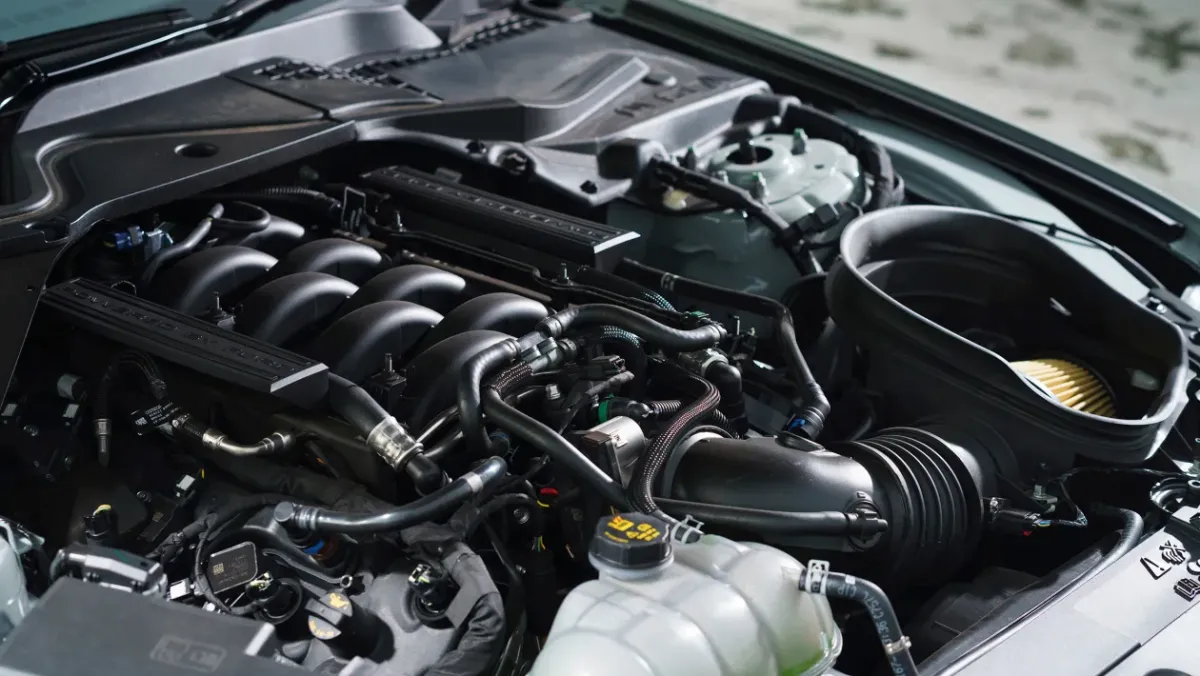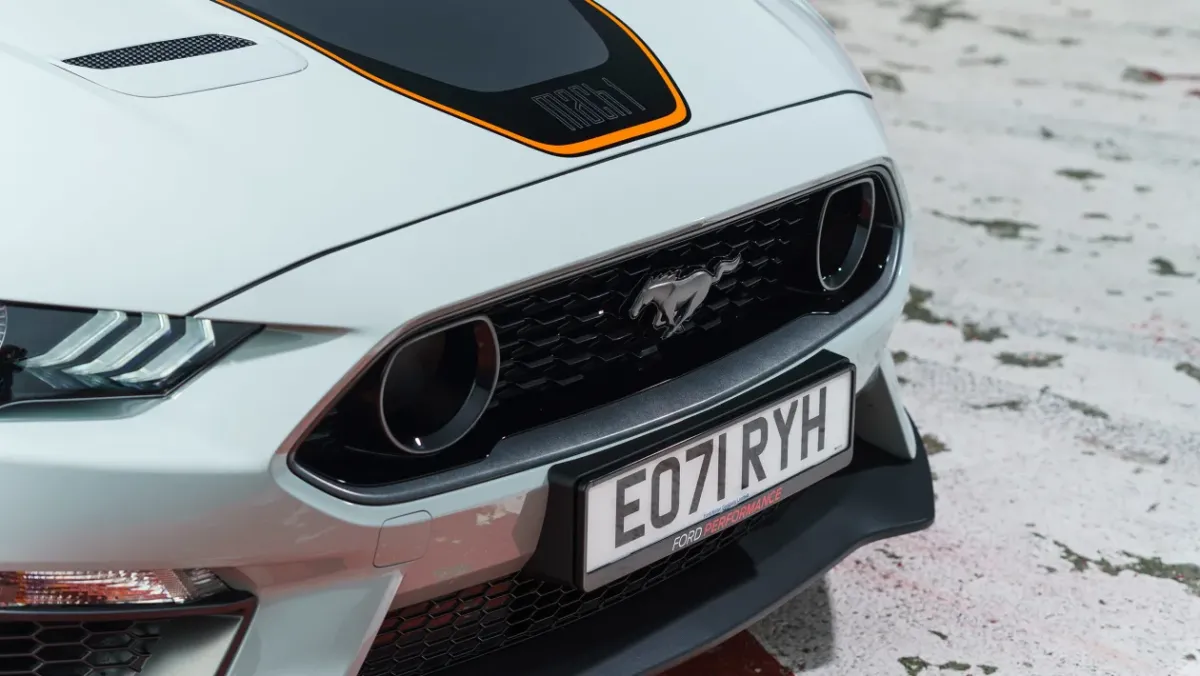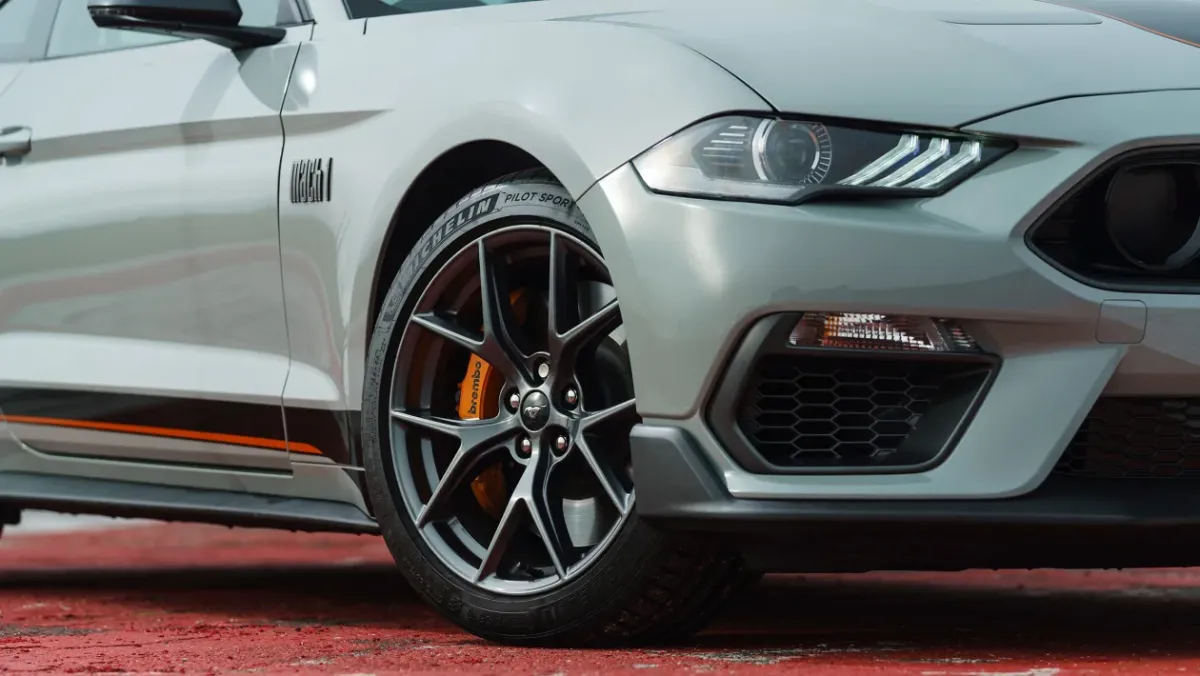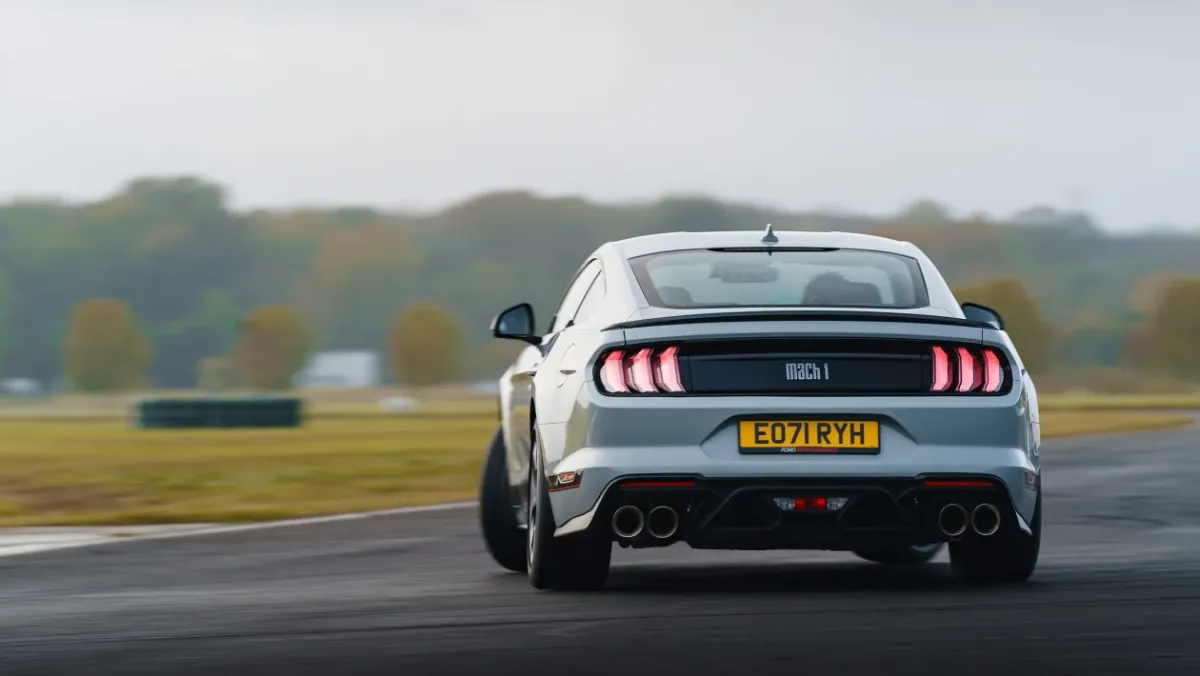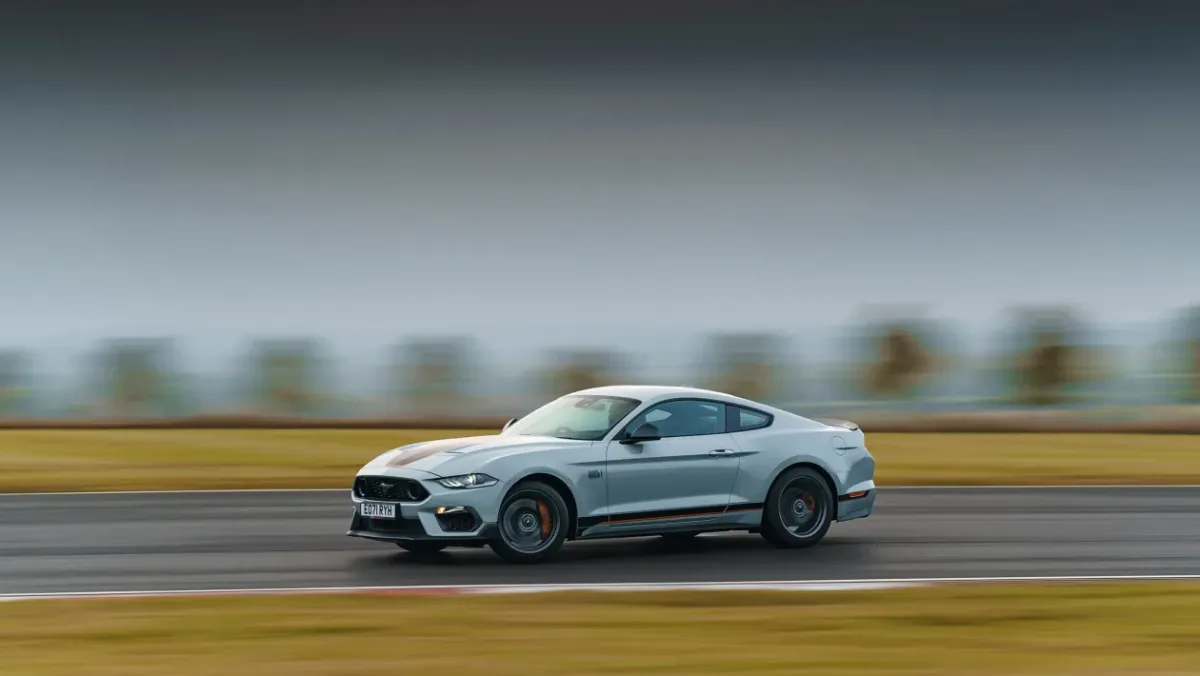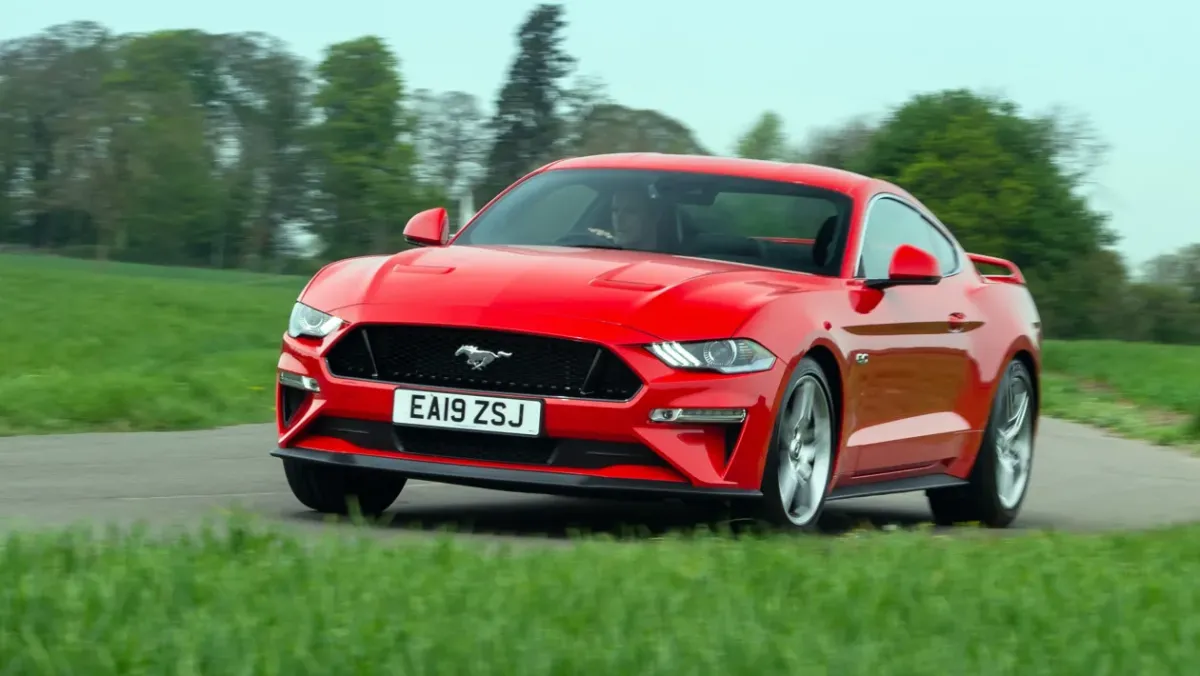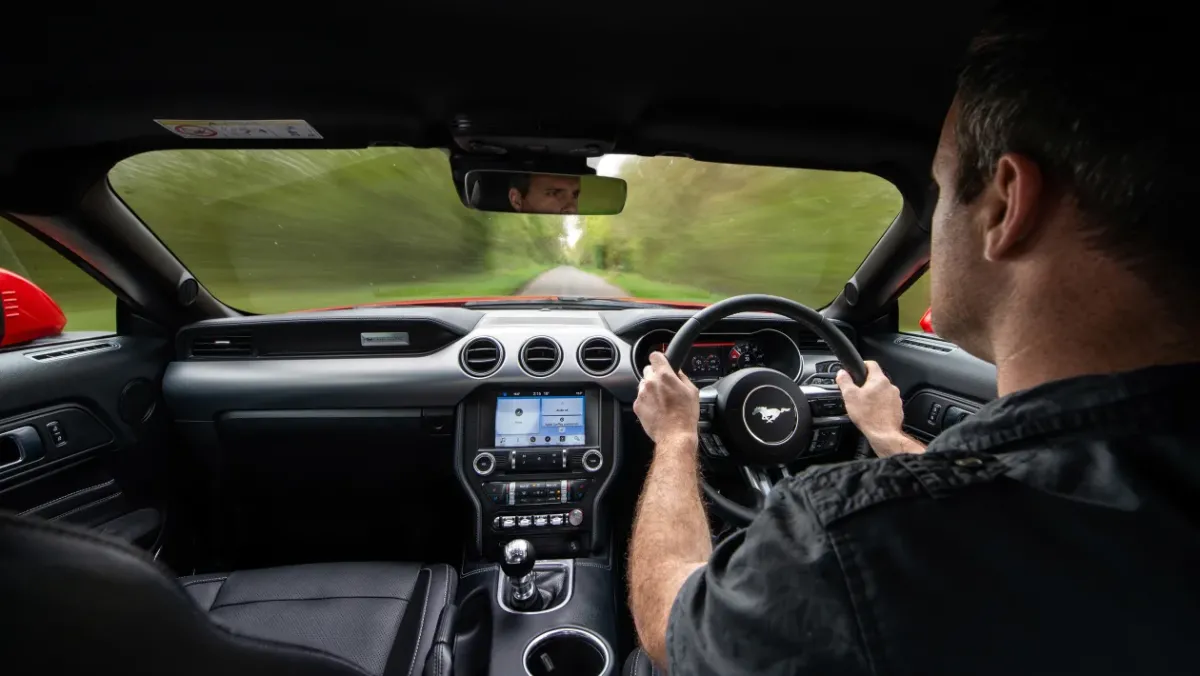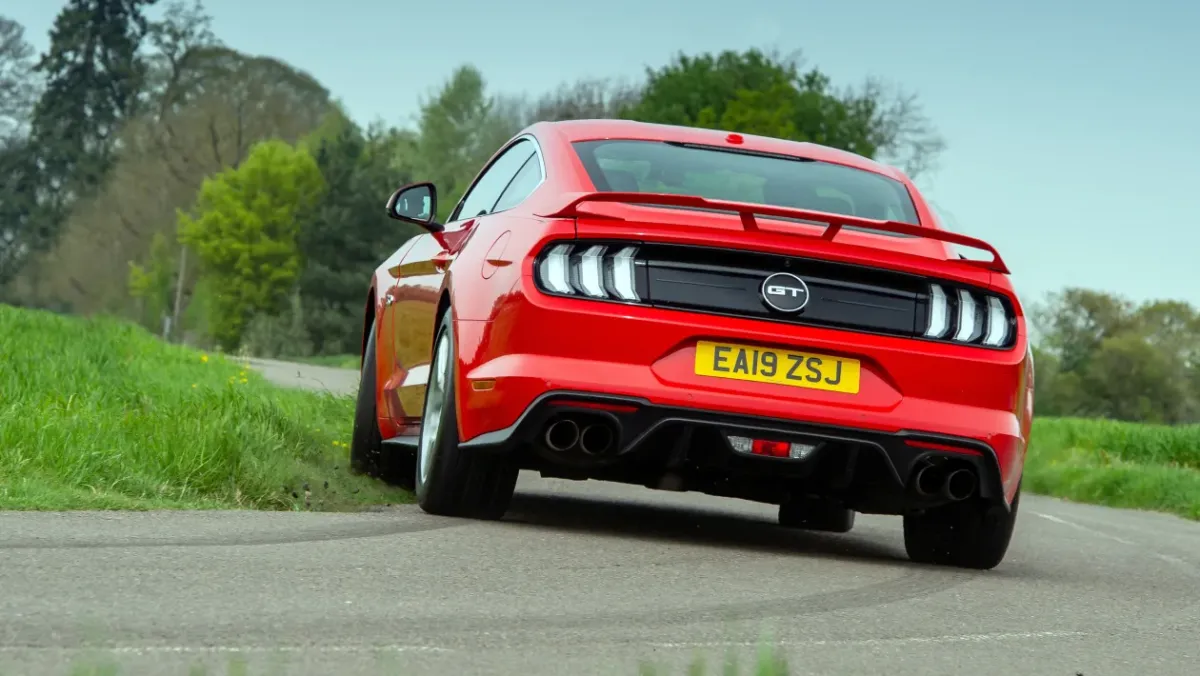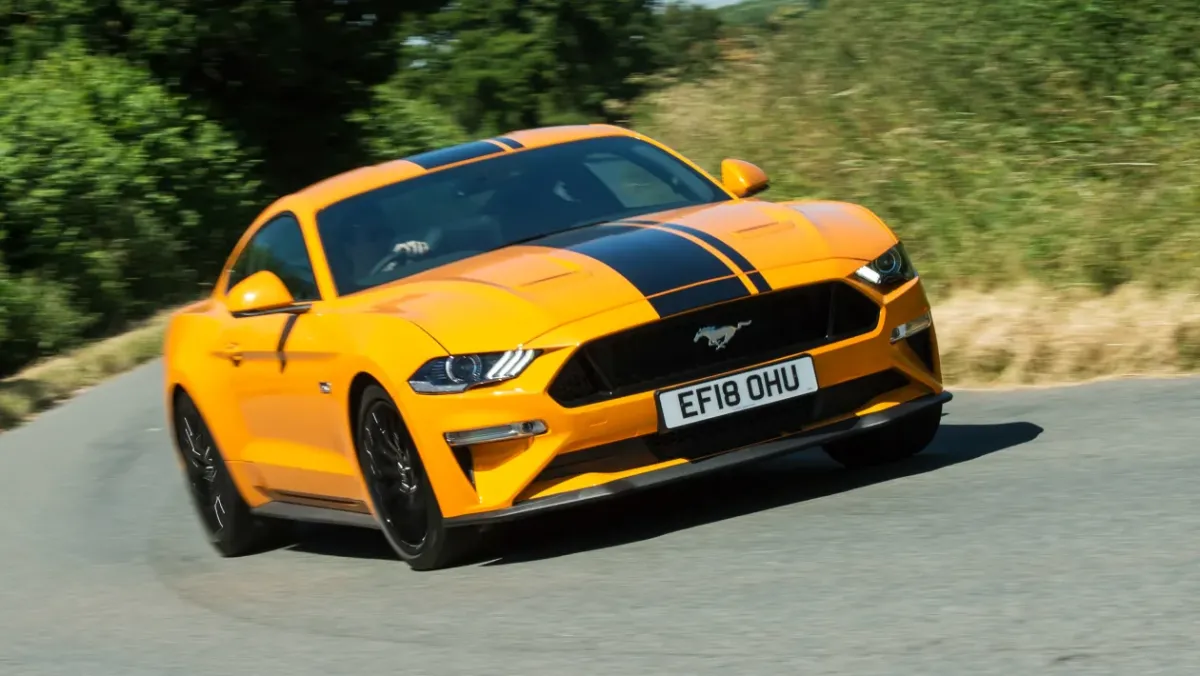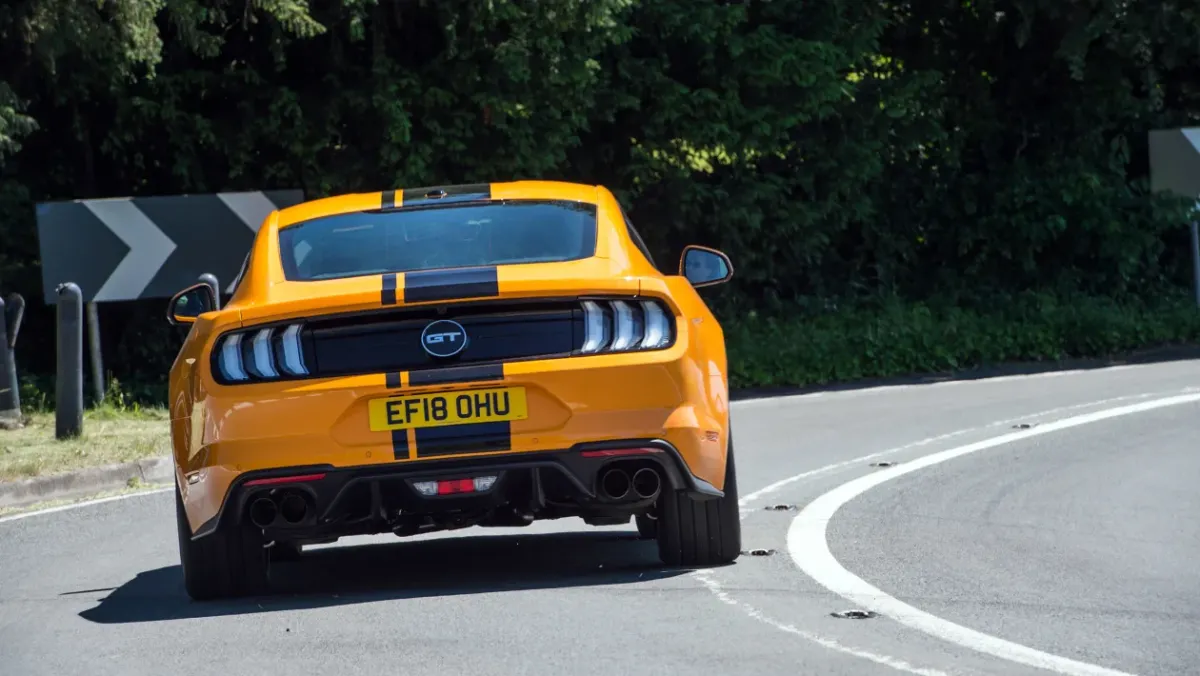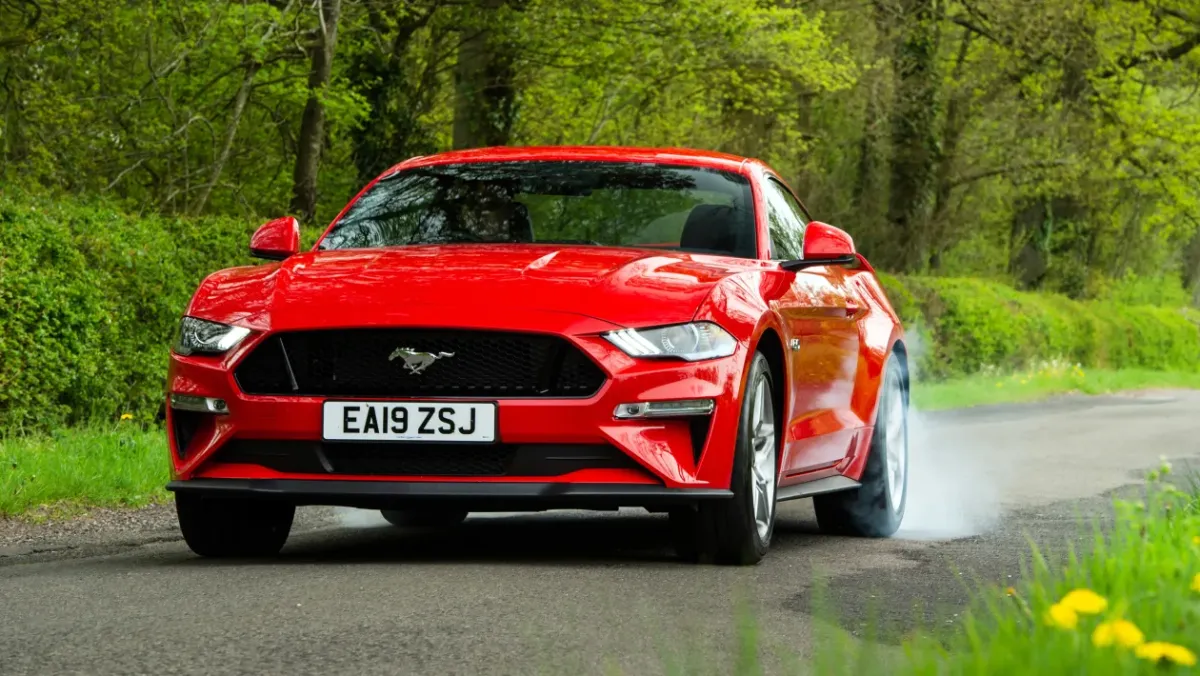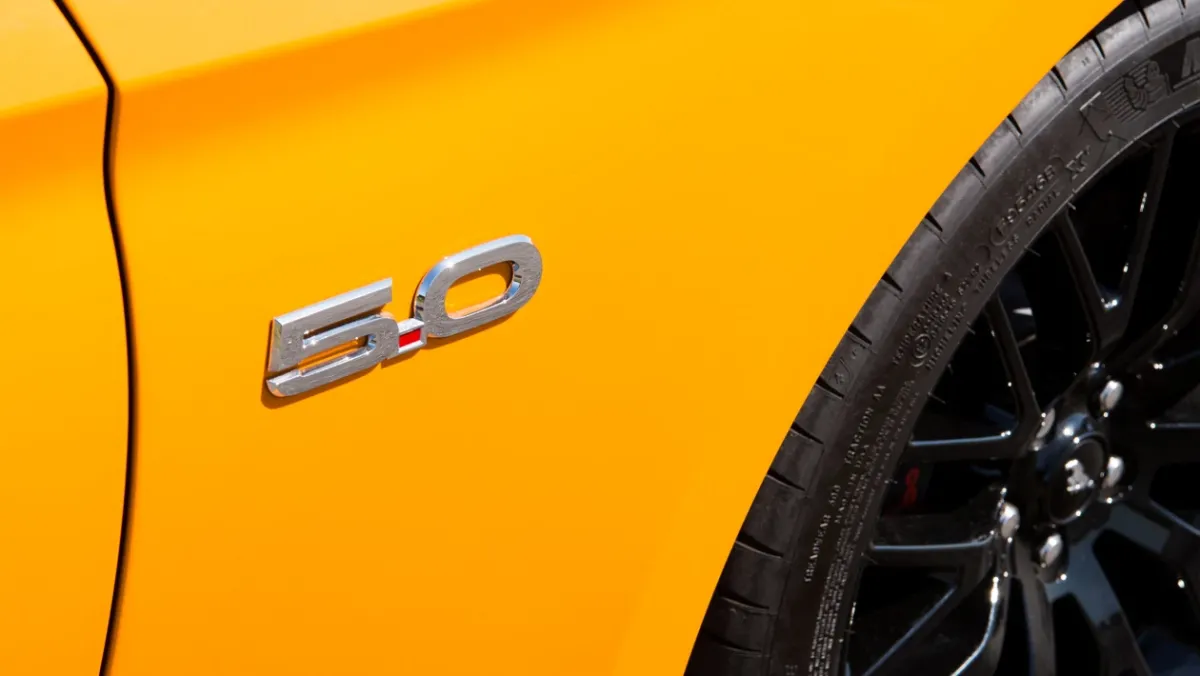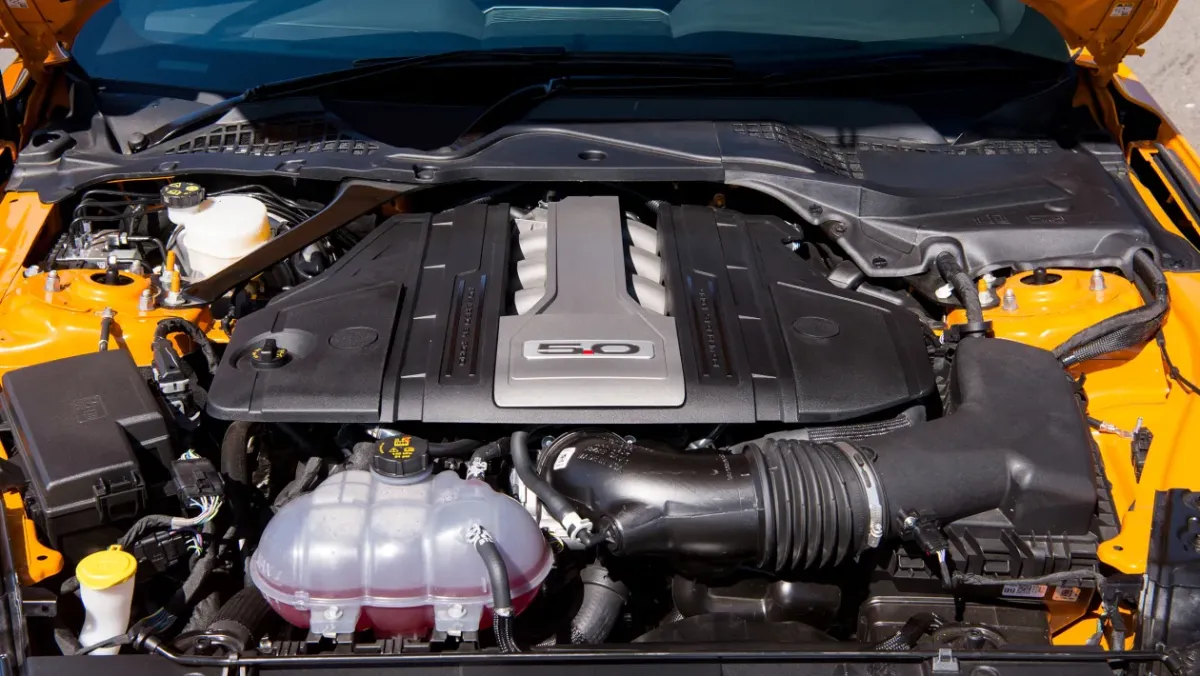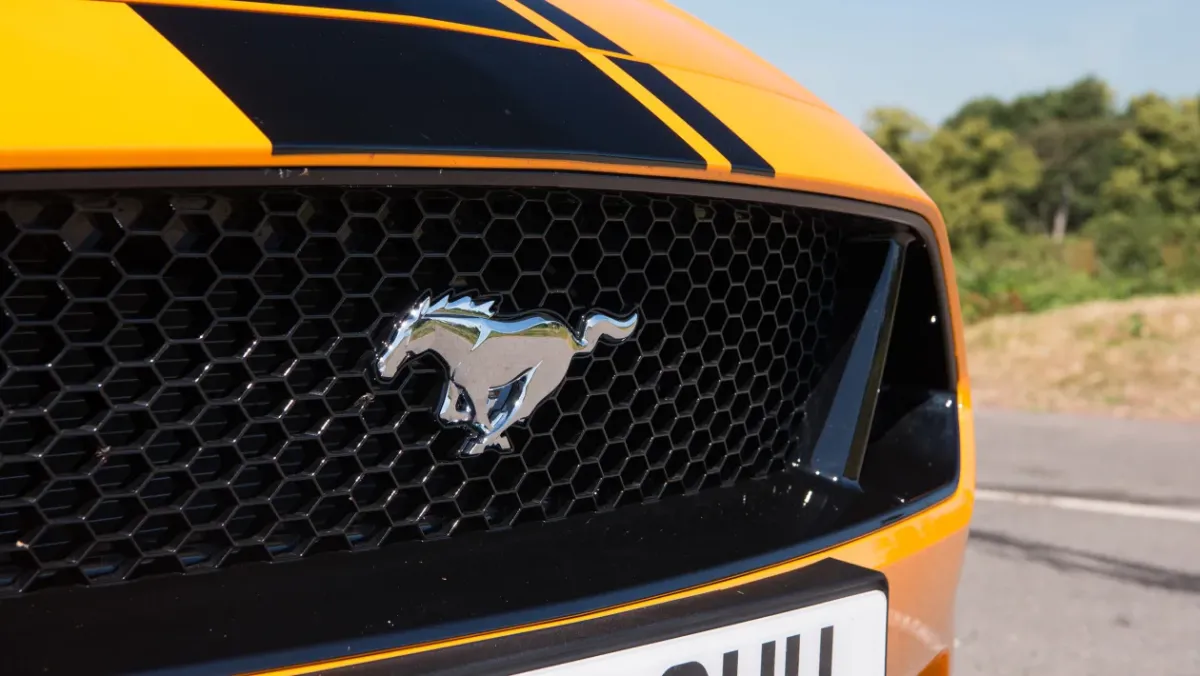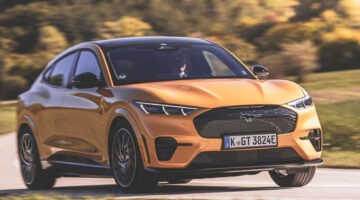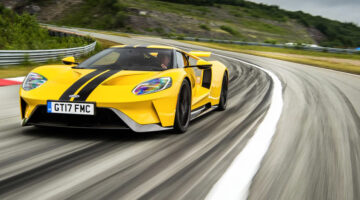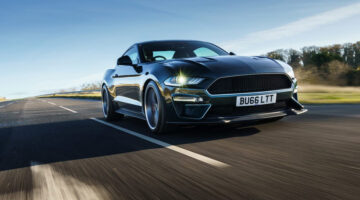Still charming us Brits, the Mustang makes for an impressive piece of American muscle, but without the judgement associated with flashier brands
| OK dynamically, imposing looks, Mach 1 the better option | |
| Still falls short of its European rivals for ability and build quality |
PRICE: From $45,000
The Ford Mustang is intrinsically tied with the United States of America, and whose image is just as associated with the Americanisms of liberty, prosperity and freedom as it is the bald eagle and warm apple pie. Yet, while democracy and capitalism are certainly things we in the UK share with the USA, the cultural differences often make cross-pollination in the car industry a sometimes jarring affair. So how does the Mustang get on when placed in our decidedly smaller ecosystem?
Well, despite starting up official right-hand-drive production for the first time alongside the current generation’s introduction in 2015, Ford hasn’t gone to any lengths to anglicise the Mustang – it’s as big, brash and bombastic as ever. But as we’ve found out over the years, this is no bad thing.
That’s because the recipe of a big engine up front, four-seater coupe or convertible body and rear-wheel drive hasn’t changed. There was a four-cylinder engine available once, but while there are production issues due to the global supply chain crisis, Ford has shifted production to focus on the V8s, with the GT and new Mach 1 the only two options available here in the UK, both with either six-speed manual or ten-speed automatic transmissions.
And the good news is that despite spawning an electric counterpart with the same name (Ford’s all-electric Mach-E), the traditional Mustang will continue in a heavily updated form from later this year, eventually finding its way back across the pond to remain on sale for as long as Ford’s allowed to sell it.
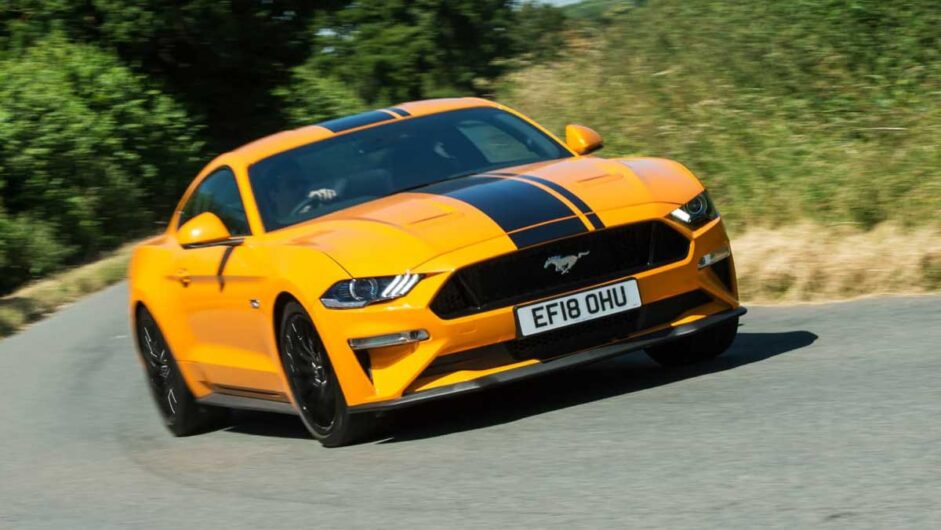
Prices, specs and rivals
The removal of the entry-level four-cylinder EcoBoost model, increased shipping costs and restricted supply has meant the Mustang’s headline-grabbing entry price of under £40,000 is now long gone, with the V8-powered GT starting at £50,075. Throw in the ten-speed automatic and you’ll need to find an extra £2000, while the GT-only Convertible version is a further £3500. There are still a few options worth ticking despite the much higher price point, too, with the very good MagneRide dampers a solid £1750 upgrade, while the uprated B&O stereo will be another £865. Thankfully, the six-piston Brembo brakes are standard fit, which is useful considering the Mustang’s chunky 1768kg weight figure.
Mach 1s come with some handy chassis upgrades including those MagneRide dampers, but you’ll have to find an extra £10k to pay for it, with its starting price coming in at £60,075. The options list is smaller for the Mach, but you will want to select the optional Recaro buckets which do something of an admiral job replacing the useless standard leather chairs, but they don’t come cheap at £2000. Forged Y-spoke wheels are another Mach 1-specific option – that’ll be a further £1000.
Rivals are varied and intriguing all at once, with perhaps the closest coming from Lexus with its RC-F. As with the Ford, the Lexus’s price points have gone into the stratosphere in the last year, with the entry-level model now costing from £68,620, making it a fair jump on even a fully optioned Mach 1. Still, where the Ford might be considered a bucket of American KFC, the RC-F is more like a platter of karaage – crisper, lighter, more refined, yet overall a similar and no less pleasurable experience.
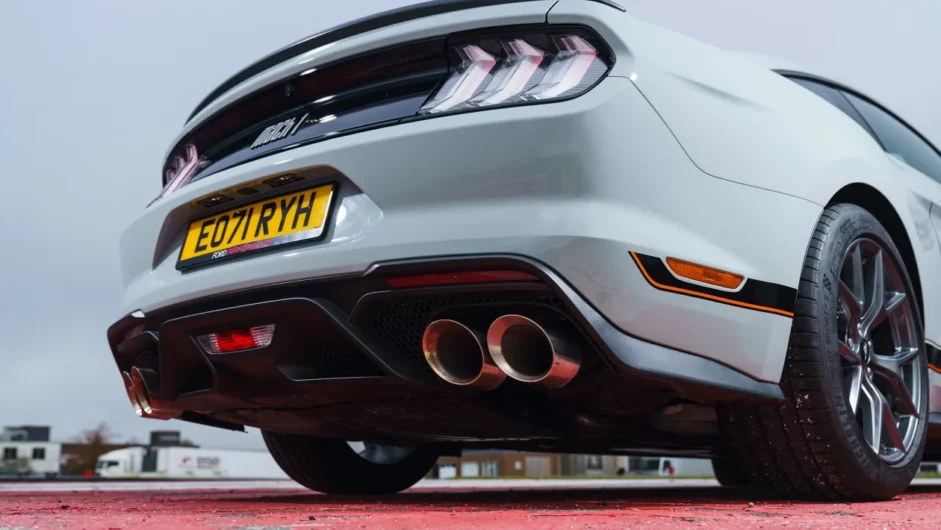
If a £50-60k sports car is what you’re after though, things are looking up as there are plenty of options across the performance car spectrum. Toyota’s GR Supra (£47,505) is one such rival. Lacking two seats and two cylinders it may be, but it’s a GT-cum-sports car in equal measure that with a few chassis tweaks and a newfound manual transmission is gearing up (no pun intended) to be one of the year’s most exciting performance cars.
The Audi TT RS (£57,315) draws a similar line between sporty and comfortable, and while it does have two rear seats, they’re only suitable for humans without a head. To drive, it’s also a very different experience, with a penchant for safe and steady handling traits that are almost the antithesis of the Mustang’s more ‘wild and free’ character.
The Alpine A110 (£49,990), Porsche 718 Boxster/Cayman (£49,000/£47,000) and Lotus Emira (First Edition is £75,995 before delivery, number plates and road tax) all operate at the sharper end of the field, compromising on practicality for a more traditional European sports car driving experience in French, German and British flavours. All are vastly superior driving experiences in a rational sense, but then all are very different cars.
Go off-piste and you’ll find the German BMW M240i (£47,515) and Mercedes-AMG CLA45 S (£60,965) both offer excellent sports car experiences – think bigger and the £56,310 M440i is also an option. BMW’s M4 Competition has risen to almost £80,000, making it a much more serious proposition, while AMG’s C-class coupes have both been given the flick in preparation for the slightly larger CLE that’ll be ready to replace both it and the E-class coupe next year.

Used and nearly new Ford Mustang models
The Mk6 Mustang is a pretty useful used purchase, especially if you go for the V8 models with the manual gearbox as it’s an entertaining proposition in this guise. The four-cylinder model is OK, but without a V8 under the bonnet you’re missing out on half of the muscle car experience. There are plenty of cars to choose from despite being a fairly unusual sight on our roads, but while the earliest models have dropped to quite affordable levels, more recent cars, especially the post-facelift examples, still command strong prices.
Ford Mustang Mk6 history
Launched in the UK in 2015 the Mustang was available as a coupe or convertible and with a choice of a 2.3-litre four-cylinder or a 5-litre V8, the latter model giving the full muscle car experience. There were some changes in 2018 which gave the V8 a little more power and also introduced a ten-speed automatic gearbox as an option. At the same time the infotainment system was upgraded, too. Special-edition models have included the Bullitt Mustang, the Mustang55 and the left-hand-drive only Shelby GT350 and GT500. A more track-focused model, the Mach 1, made its debut in 2021, with the four-cylinder car being dropped at the same time.
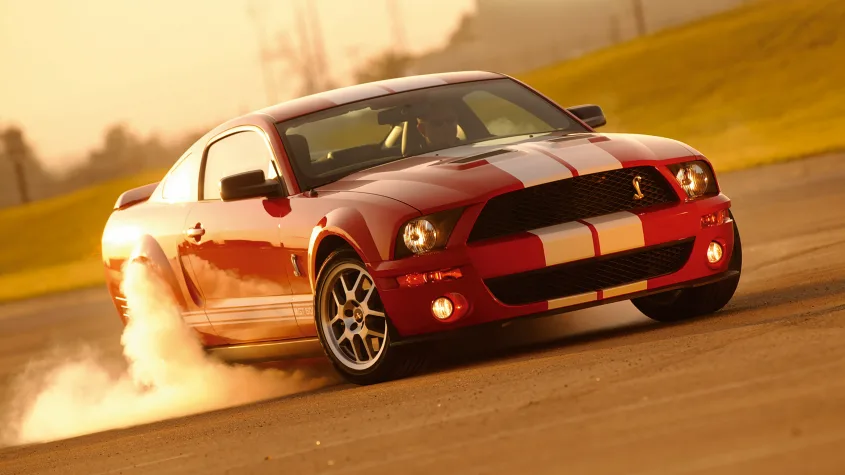
Used Ford Mustang (Mk5, 2005-2014)
The Mustangs of the ’80s and ’90s weren’t anything to write home about, with fussy styling and lacklustre underpinnings, but Ford was back on form with the Mk5 Mustang – not only did it look like a Mustang, it went like one, too. The platform was stiffer than those of the models that preceded it, and there was a choice of V6 or V8 engines developing anywhere from around 200bhp to over 650bhp. The later cars received the new 5-litre ‘Coyote’ V8 and it’s these cars that are probably the ones to go for if you can stretch to them.
Older Ford Mustang models
The original pony car, the Mk1 Mustang, was a real game changer for Ford, proving that there was a huge appetite for sports cars and selling in huge numbers. Developed in just 18 months and available as a notchback, a fastback and a convertible it featured either straight-six or V8 engines, and by using plenty of parts from its Fairlane and Falcon models Ford was able to keep the price down. It became a cult classic overnight, and while a facelift in 1969 did add weight and girth to the Mustang, it also spawned some great performance models such as the Mach 1, the Boss 302 and the Boss 429.
Performance and 0-100kph time
It comes as little surprise to say right away that a V8 engine is imperative for the Mustang. The 2.3-litre turbocharged four-cylinder EcoBoost unit is not only at loggerheads with the very ideology of the Ford Mustang, but it’s also objectively rough, slow, laggy and wholly unsuited to it. Not that you’ll need to know, but the EcoBoost Mustang takes a glacial 5.8sec to reach 100kph when fitted to the manual transmission, with the automatic shaving 0.3sec off that time thanks to the short gearing.
The naturally aspirated 5-litre ‘Coyote’, on the other hand, is everything you might reasonably expect of an American V8. Performance is good, and since its midlife update has picked up some extra power and torque, but the powertrain needs revs to feel the figures, despite some serious cubic capacity.
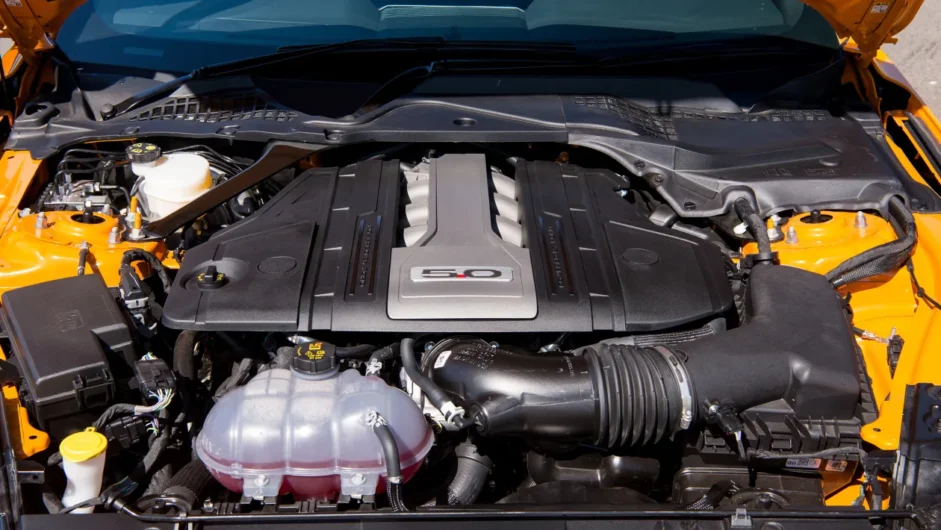
As a result, the Mustang’s 1768kg kerb weight does take the sting out of the mid range, but rev the engine and it absolutely feels its power figure, hitting 62mph in 4.7sec when fitted with the automatic gearbox, and 4.9sec with the manual. Convertibles add 0.2sec to the respective transmissions.
Upon the Mach 1’s arrival, Ford killed off the previous Bullitt range topper. That car was more of an aesthetic special edition, whereas the new car is much more serious, with upgrades to both powertrain and chassis that, in the USA, bridge the gap to top-drawer Shelby variants. Performance is only marginally up on that of the standard GT, taking 4.4sec to reach 62mph with the automatic transmission, and 4.8sec with the manual.
Engine and transmission
The 5-litre ‘Coyote’ V8 that powers the current Mustang has been in use by Ford since 2011, replacing the ancient 4.6-litre ‘Windsor’ that went before. On its first application in the current-gen Mustang, it produced a reasonable 410bhp, and following the car’s midlife update that figure has jumped to a 992 Porsche 911 Carrera S-matching 444bhp. The Mach 1 features an identical take on the Coyote V8, but adds a further 10bhp to the total 250rpm further up the rev range. Torque remains identical between the two at 390lb ft.
As mentioned before, the 2.3-litre turbocharged four-cylinder EcoBoost has now been removed from sale in the UK, with Ford USA citing production issues related to the chip shortage. It will likely return, though, forming an entry point to the range as it once did. Not only is the 286bhp power figure comparatively low, it’s also produced sky-high in the rev range at 5600rpm, giving you a fair idea as to the amount of turbo lag that must be fought against in reaching that number.
Both Mustang GT and Mach 1 are available with two transmission choices: a six-speed manual and a ten-speed automatic. The manual has a satisfyingly hefty shift, in keeping with the car’s rough-and-ready image. Shifts aren’t always clean though, and rush through gates and it can feel a little cumbersome and clunky.
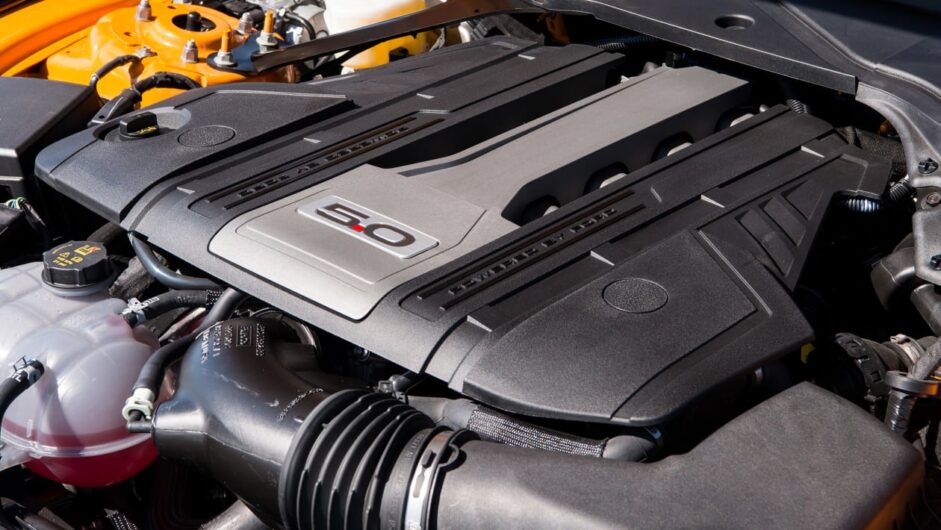
But we now come to the automatic transmission. Launched alongside the mid-life update last year, the all-new ten-speed torque converter automatic was co-developed with General Motors in a rare show of bipartisanship between the two arch rival companies. Spread throughout both model ranges in everything from giant F-150 pickups to the mad 600bhp Camaro ZL1, you might say that this is a troubled transmission.
Its biggest problem is that like all ten-speed autos, there are just too many gears with too little difference in ratio for the car’s brain to keep up with. The car shifts so frequently that the engine barely has time to breathe, something especially prevalent given the mechanical inertia that is inherent in the V8 engine. A similar murmur could be said against other ten-speed boxes, but the Ford’s slow, slurring shifts and overactive torque converter make it feel like the car is rarely fully engaged in a gear.
Take control with the paddles and the transmission’s convoluted software is less of a problem, but the car still suffers from shudderingly slow shifts, leaving you totally unaware of whether a gear is engaged, causing the revs to flare if you apply throttle during the constant stream of shifts, then surging forward as a gear does eventually engage. It knocks your confidence in the car, never giving you any assurance as to whether the power under your right foot is connected to the road or hidden away in the driveline.

In the USA, Ford has killed off nearly all other engine variants, including the brilliant 5.2-litre ‘Voodoo’ V8 with a flat-plane crankshaft, as used in the Shelby GT350 and GT350R, but does still offer the brilliant flagship GT500, packing 760bhp from a supercharged version of the GT350’s 5.2-litre V8. It’s not just the engine that’s been to the gym, as power is sent to the same Tremec seven-speed dual-clutch transmission as in the Ford GT supercar, and boy is it a brilliant combination.
If that still doesn’t sound powerful enough, then there are plenty of tuners who will help eke out much more power from the Mustang’s 5-litre V8. One of those firms is Sutton Bespoke, which offers a range of power upgrades, from remaps to supercharger conversions. We’ve tested the CS700 and CS800, both of which are supercharged and which put out a lot more power than standard – 690bhp and 825bhp respectively. Despite significantly more power, neither seems as phenomenally fast as those figures might suggest, but the engine, chassis and visual upgrades do make the Mustang more desirable and give it real presence.
Ride and handling
The Mustang might not feel like such an exotic sight on UK roads since it arrived through official channels back in 2015, but to drive, it still feels anything but familiar. Drive it through a British village and it feels wide, long and totally out of scale with the traffic (and architecture around it).
It’s not quite as agricultural as it once was – Mustangs have been on independent rear suspension for a while now, but it’s still a very different experience in comparison to that of modern European coupes such as BMW’s 4-series. That’s not to say the experience is a bad one, of course. It’s just that the cumbersome steering and relative lack of mobility takes some getting used to.
Get past this initial intimidation and there’s a fluency to the car’s responses and a reasonably settled ride quality, especially on the impressive MagneRide dampers. It’s a fairly intuitive car to drive quickly, too, with a consistency and natural weight to the steering, plus a nice balance that manifests itself below the limits of grip. Unfortunately, there’s little actual feedback through the steering or chassis, which means there’s some second-guessing when approaching those limits, which come around quicker than you might imagine.
Once at speed, the Mustang begins to lack ultimate body control – the dampers sometimes struggle to keep track of the car’s mass during quick direction changes, making it difficult to confidently ascertain where the weight is within the chassis. And weight there is, as the Mustang feels every bit of its 1760kg-plus figure. On expansive US roads the Mustang calls home, you’d probably not notice, but on the sort of broken B-roads found across the UK it results in the Ford feeling a little out of its depth – a little flustered and ponderous.
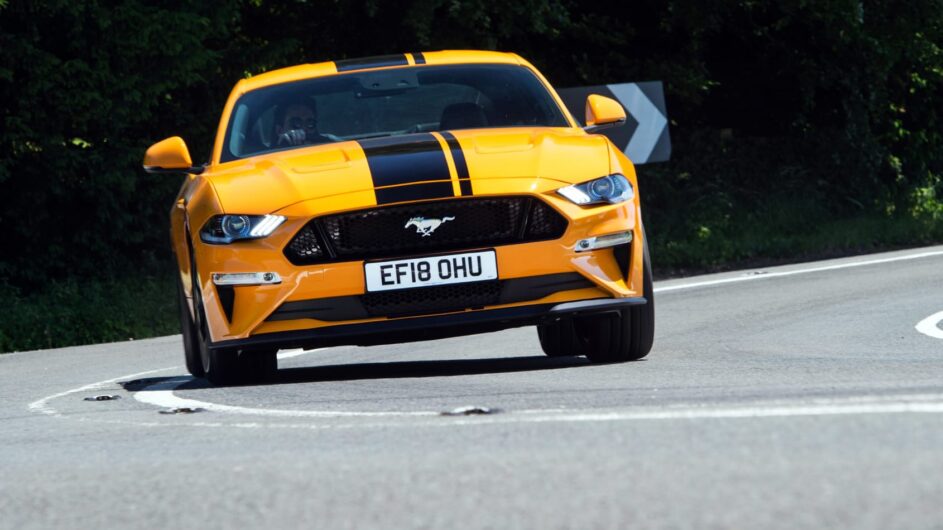
The steering doesn’t help, as Europe’s obsession with fitting a super-quick steering rack makes the Mustang’s feel ponderously slow by comparison – this is something that doesn’t usually grate on us, but when combined with a lazy chassis can feel obstructive when trying to take a road apart.
Recent experience with a Mustang equipped with a Koni Sport suspension set-up reveals only a little adjustment is needed to tease out the car’s potential, though. With more body control and a lower ride height the ’Stang is at once a little more planted and a little more exploitable, without destroying the decent ride quality.
The Mustang’s brakes are strong, but their response isn’t perfect. Bite is almost instant and the pedal travel is quite short, making smooth, progressive braking more difficult than it should be. Wide spacing between brake and throttle pedals, and that grabby initial bite, also makes heel-and-toe downchanges difficult. Incidentally, it’s a problem not nearly as bad in the left-hand-drive car we drove most recently.
Despite these issues, the Mustang is still a lot of fun. Drive it below its limits and stick to smoother tarmac and it becomes much easier to appreciate the car’s good balance and progressive responses.
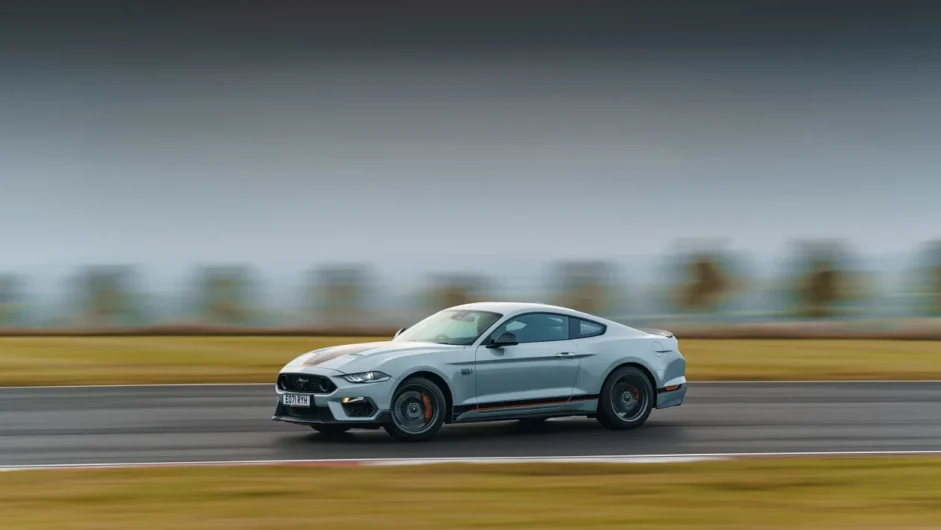
This is where the Mach 1 comes in, as it features a raft of chassis upgrades derived from the Shelby GT350 that significantly improve the car’s responses up to and beyond the limit. Both front and rear subframes are new, with stiffer anti-roll bars and stiffer springs and dampers at all corners. The MagneRide dampers (standard fit on Mach 1s) are also recalibrated to suit, and give the whole car a much more controlled ride quality on rougher British roads. It’s a little firmer on the road, yes, but it’s also significantly more tied down, and in combination with a quicker and more direct steering rack seems to shrink the Mach 1 on the road. It still feels like a Mustang, but a smaller, sharper and more responsive one – exactly the sort of thing we were asking for, and are so glad we got.
The Shelby GT500 takes things even further, and with staggering results, as the extra capability within the chassis, extra rubber on the road and extra power and response from the drivetrain make it not just quicker, but far more engaging at the same time. Rather than feeling like an over-engined muscle car – it does have 760bhp – the GT500’s real talent lies in how it makes all that power and performance feel so approachable.
L/100km and running costs
The V8 engine manages between 22.8 and 23.7mpg depending on the model, with CO2 emissions hovering between 284 and 256g/km. Fuel costs will therefore be high whichever way you look at it, although with some gentle persuasion we saw up to 26-28mpg when on a gentle motorway run. One upside to the automatic is a gentle rise in mpg for both engines, thanks to the incredibly long tenth gear, which will sit the Mustang at pretty much idle at 70mph. Driven hard, though, and both will guzzle fuel at an impressive rate (we’ve seen single figures on track in the V8).
Tyres are likely to be the most regular expense. In standard specification you’ll be looking for 225/40 R19 rubber at the front and 275/40 R19 at the rear, making a pair of replacement Pirelli P Zeros £145 each on the front wheels and £188 each at the rear (both before fitting, from blackcircles.com).
The high CO2 figures also generally put the Mustang in a top bracket when it comes to VED, company car tax and even parking permits (welcome to 2022), meaning that its running costs will often sit higher than its purchase price would suggest – a modern BMW M4 Competition is generally 60-70g/km under the Mustang’s figure.
Interior and tech
The muscle car persona is just as visible inside the cabin, with the dashboard architecture taking inspiration from Mustangs of the past. However, it’s not quite as commodious as its enormous exterior dimensions might lead you to think, thanks in large part to supersized elements such as the seats, centre console and dash.
Build quality is unsurprisingly a weak point, with hollow materials and a lack of solidity around the doors, dash and console that do take the shine off the now pretty serious price point. Ford has tried to make things interesting, though, with plenty of (faux) stitching and (faux) metallic plastic trim brightening up the otherwise dark interior.
> Ford Mustang Shelby GT350R review – A muscle car for the track
Tech is better, however, with Ford’s simple infotainment system joined by a surprisingly high-resolution digital dial pack. And while the variety of information shown isn’t that configurable, there are plenty of options as to how the Mustang’s basic info can be displayed, with various colours, rev counters and shift light options allowing the driver to make it their own.
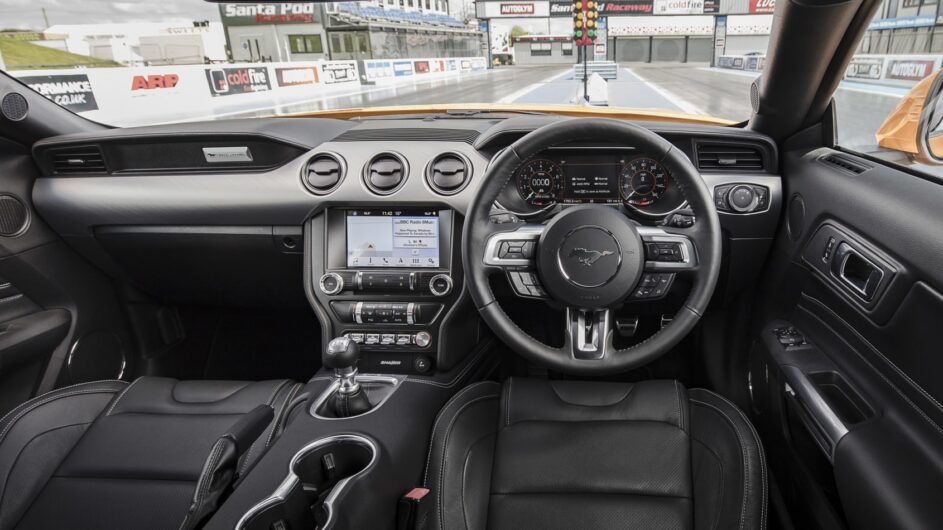
The standard seats severely lack side support, and although squishy and comfortable for short periods they begin to wane over longer journeys. Recaro seats are available as an option, which we would highly recommend, but all seats sit far too high and come with limited adjustment, especially for short drivers (like yours truly).
Cabin noise is fairly low – unless you’re really extending the engine – and there’s only a rustle of wind and tyre noise. It all feels very American in fact, but in the best way possible. Pity the view over the long bonnet is of a rainy, windswept UK rather than the Pacific Coast Highway.
Design
Even though it has had time now to become a familiar sight on roads, the Mustang still turns heads like few others, with a friendlier reaction than one might usually get in ‘normal’ sports and supercars as a bonus. Everyone loves the Mustang, and the latest aesthetic updates have just sharpened its aggressive, yet approachable good looks.
One perfect example is from a sandwich shop nearby the our offices. Turn up in a Lamborghini, McLaren, Porsche, anything like that and the only feedback is whether we would like a can of coke with our order. Turn up in even a subtly specced silver Mustang convertible, and it’s the talk of the day. Uncanny.
While there is still some level of customisation with optional decals and rear spoilers, most of the variable wheel options, brightwork and badging are now off the menu for UK buyers. If you’re really into a bespoke look for your American muscle car, though, it is worth remembering the huge tuning scene in America makes customising off-piste an easy, but expensive, enterprise.
The Mach 1 looks even better than the standard car, with a nice combination of retro elements, such as the standard wheels and badging, and some contemporary touches around the rear fascia and lower front bumper. For 2022, more of Ford’s current colour range is now available, including new shades of dark green, dark purple and a three-layer maroon joining the usual combination of sleek or bright base colours.
This article originally appeared at evo.co.uk
Copyright © evo UK, Dennis Publishing

